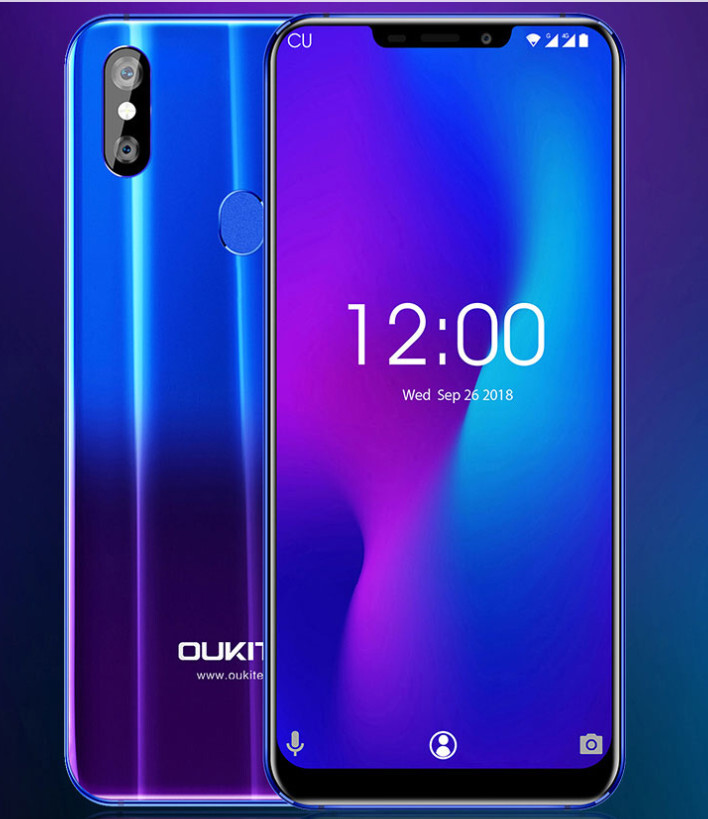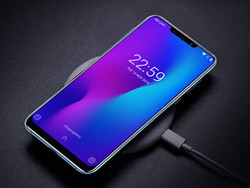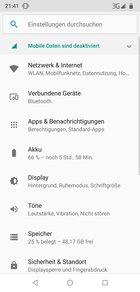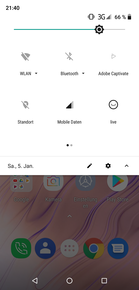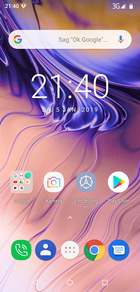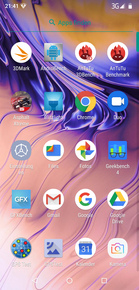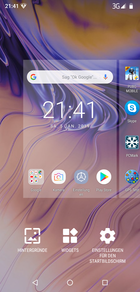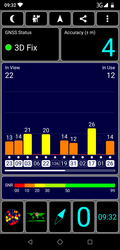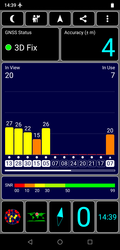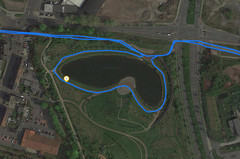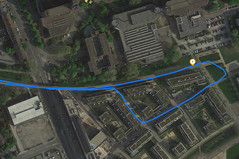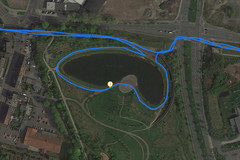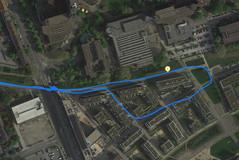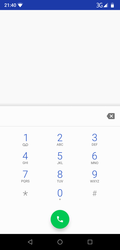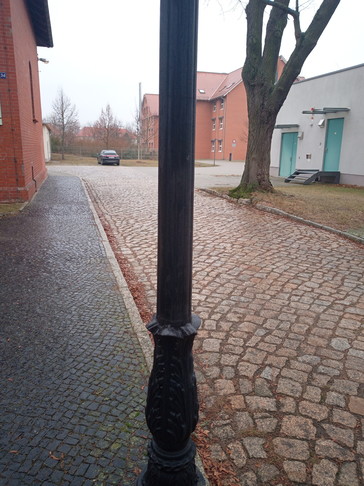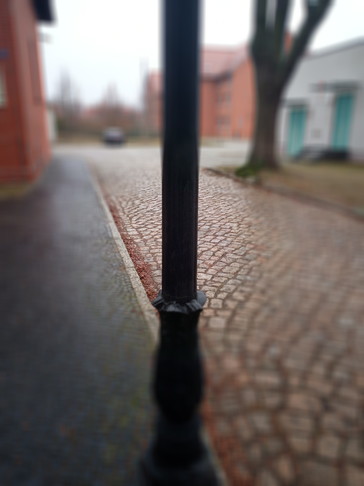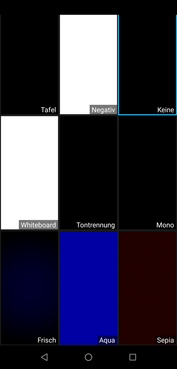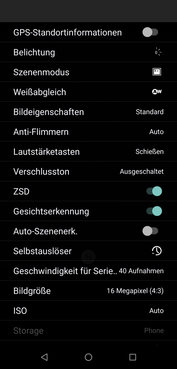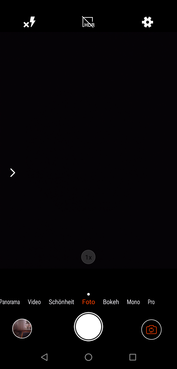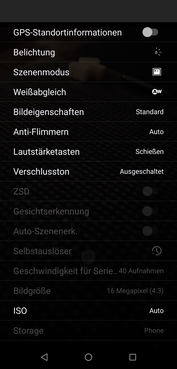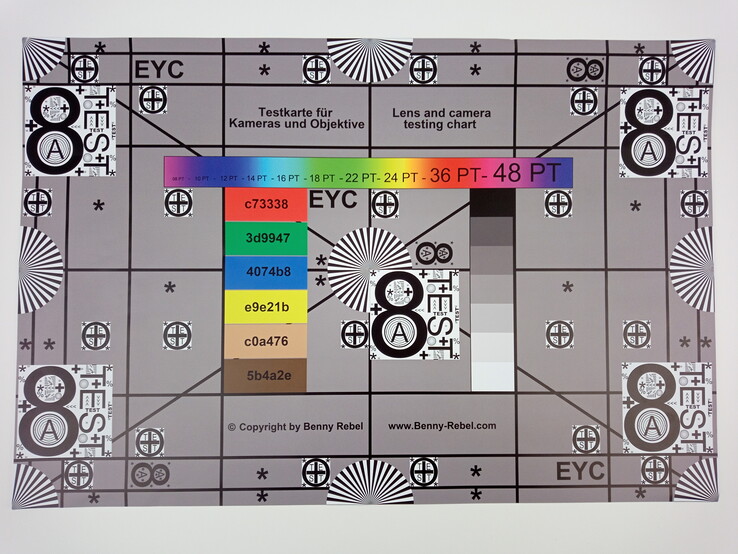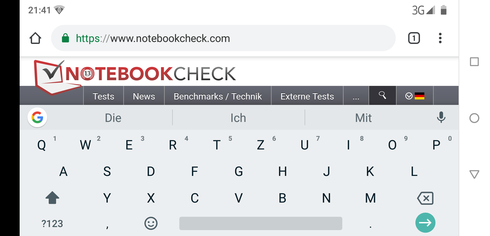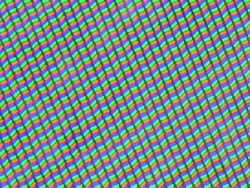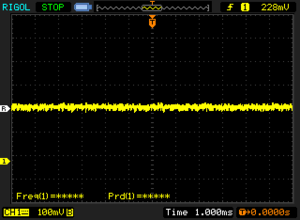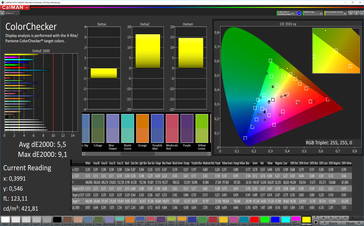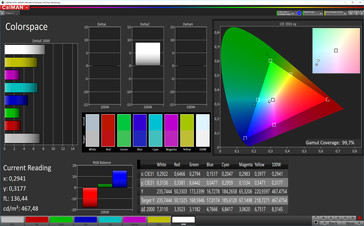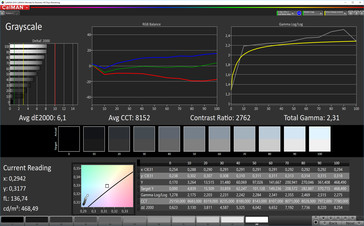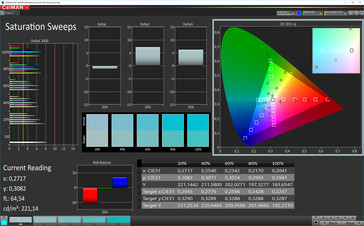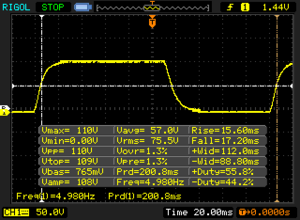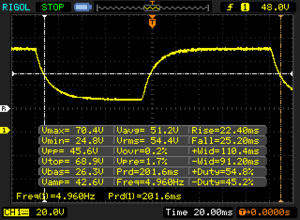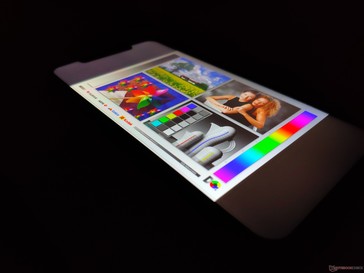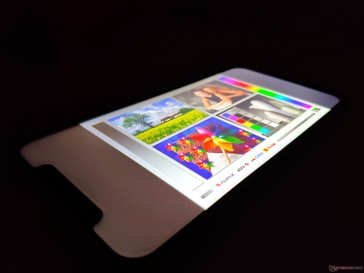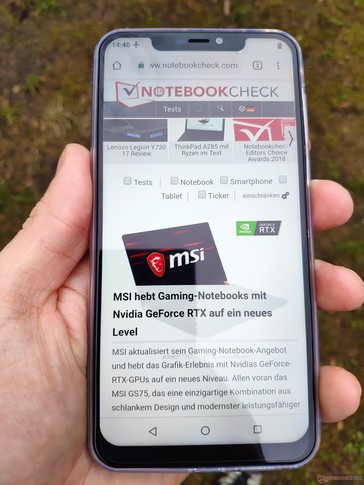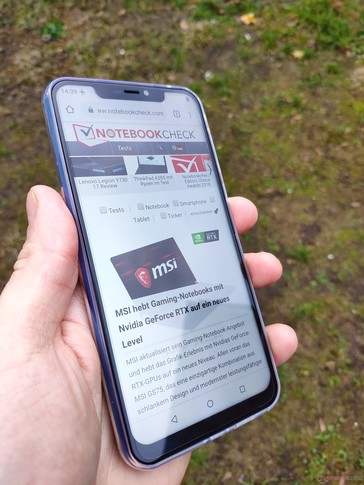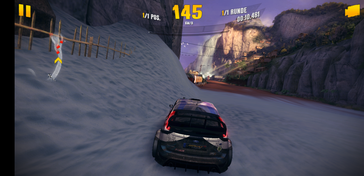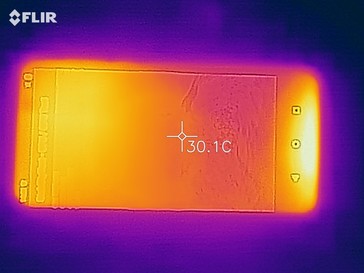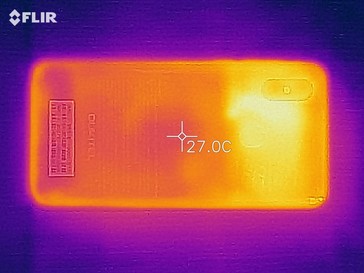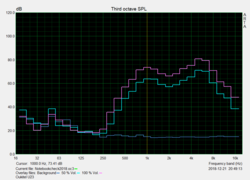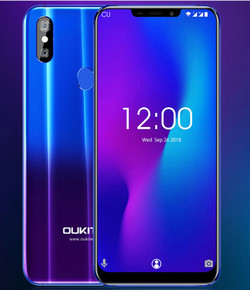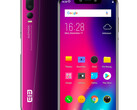OUKITEL U23 Smartphone Review
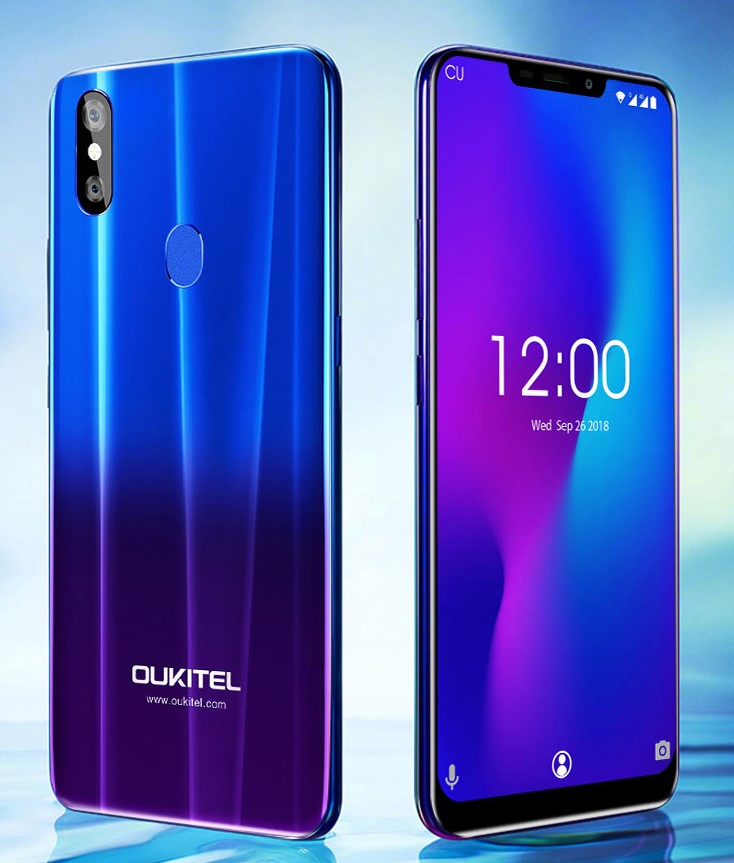
OUKITEL’s U-series stands for design and aesthetics. Accordingly, the U23 also has a distinctive design and is one that reflects modern smartphone trends. The back has a striking gradient finish that looks like Huawei's Twilight colour that was used with the Mate 20 Pro. Likewise, the U23 has a notched display and narrow display bezels, which has been a popular design decision with smartphone manufacturers since the introduction of the Apple iPhone X in 2017. Moreover, the vertical dual rear-facing camera array looks remarkably like the one that Apple and Huawei have used over the last few years.
The U23 has a 6.18-inch IPS display that operates natively at 2246x1080. The device is powered by a MediaTek Helio P23 SoC that integrates an ARM Mali-G71 MP2 GPU, 6 GB RAM, 64 GB of eMMC flash storage and a 3,500 mAh battery. The device can also be charged via USB Type-C or with a Qi wireless charger, which are both still rare for a sub-US$200 smartphone. The inclusion of face unlock and a fingerprint sensor are welcome too.
We have chosen to compare the U23 against other comparably priced midrange smartphones. Our comparison devices include the BQ Aquaris X2, Honor 8X, Nokia 5.1, Samsung Galaxy J4 Plus (2018), and the Xiaomi Mi 6X.
Case
The U23 is mainly made from plastic and glass. Our test device measures 154 x 76 mm and has an approximately 82% screen-to-body ratio. These values may sound good on paper, but the U23 is thicker than all our comparison devices at 9.3 mm. The U23 is more compact than the Honor 8X, Galaxy J4 Plus (2018) and the Mi 6X and sits comfortably in our hands.
OUKITEL has built and chosen materials for the U23 well, although the plastic back feels hollow and is easy to depress. The physical buttons sit firmly within the frame though and are easy to reach. Both buttons have clear pressure points too.
The U23 currently only comes in “Gradient Blue”, which changes from blue to purple depending on how light hits the back plastic. The colour gradient makes the U23 look more premium than most smartphones at this price, although the plastic back will not catch as much light as the glass-backed Mate 20 Pro does.
Connectivity
The U23 is comparatively well-equipped for a sub-US$200 smartphone. The device not only has a USB 2.0 Type-C port but also supports Qi wireless charging. Our test device charges wirelessly at around 10 W, for reference. The U23 supports USB On-The-Go (OTG) too, which allows you to connect USB flash drives or other USB peripherals.
OUKITEL has equipped the U23 with 64 GB of eMMC flash storage, of which 52 GB was available on our test device when we first booted it. The U23 also supports up to 128-GB microSD cards should you need more space. Our test device can format microSD cards as internal storage, which means that it can store apps or data on expandable memory. The U23 does not support exFAT though, which limits file sizes to 4 GB.
The U23 also has an FM radio, a fingerprint sensor and it supports Wi-Fi Direct. Moreover, wireless transmitting display content to external monitors via Miracast worked flawlessly during our tests with a Sony Android TV. Unfortunately, OUKITEL chose to omit the headphone jack, so you can only connect traditional headphones via USB Type-C. The company included an appropriate adapter with our test device though, but the lack of a headphone jack feels unnecessary given how thick the U23 is.
Software
The U23 ships with Android 8.1 Oreo, which OUKITEL has customised with its own UI. Our test device arrived with October 2018 Android security patches installed, which were a few months old at the time of testing. OUKITEL has not confirmed whether it plans to update the U23 to Android 9 Pie.
OUKITEL has slightly tweaked the UI compared to stock Android, but the differences are minor and should not need any time to adjust to if you have used an Android smartphone before. The company does not install any third-party applications on the U23 either, which is pleasing.
Communication & GPS
The U23 is a dual-SIM device but its second SIM slot is a hybrid one, which means that the device can be equipped with either two nano SIMs or a single SIM and a microSD card. The U23 supports LTE Cat. 6, which theoretically allows it to achieve 300 Mb/s download and 50 Mb/s upload speeds. The device only supports five LTE bands, so we suggest checking whether the U23 supports the LTE bands used in your country before purchasing it. The device supports all major GSM and 3G frequencies too. There is also Bluetooth 4.2 for near-field communications.
The U23 supports modern Wi-Fi standards up to IEEE 802.11n and can connect to either 2.4 or 5.0 GHz Wi-Fi networks. The Wi-Fi range of our test device is disappointing though. Moreover, we recorded a -46 dBm attenuation when we tested the U23 next to our Telekom Speedport W921V router, which is rather high. Our test device also performed underwhelmingly in iperf3 Client Wi-Fi tests with our Linksys EA8500 reference router and averaged less than 80 Mb/s in both tests. Only the Galaxy J4 Plus (2018) performed worse than the U23 out of our comparison devices in these tests.
The U23 uses the GPS, GLONASS and SBAS for location services. Our test device finds a satellite fix with up to four metres accuracy whether we are indoors or outdoors, which is impressive.
We also took the U23 on a bike ride to compare its location accuracy against our reference navigation system, the Garmin Edge 500. Our test device performed well and only deviated by 60 metres over the 9.33 km that our Garmin recorded us having cycled. The U23 occasionally could not match the precision of the Garmin’s GPS as the screenshots below demonstrate, but overall the U23 is accurate enough for general navigation tasks.
Telephone Features & Call Quality
The U23 does not support VoLTE or VoWiFi. The call quality on our test device is decent, and we encountered no reception dropouts during our tests. Moreover, both sides of the call sounded clear and intelligible.
OUKITEL preinstalls the Google suite of telephony apps to handle calls, contacts and messages. The apps function just like they do on other devices as demonstrated by the screenshots to the right.
Cameras
The U23 has a single front-facing camera and dual rear-facing sensors. The main rear-facing camera is a 16 MP Samsung CMOS sensor that has an f/2.8 aperture and supports phase detection autofocus. Both the 16 MP rear-facing camera and the 8 MP front-facing sensor can record videos in up to 1080p at 30 FPS.
The secondary rear-facing camera is also a Samsung sensor. The 2 MP camera theoretically provides depth of field data to help improve bokeh-effect photos. However, bokeh-effect photos are generally a blurry mess as our photos below demonstrate. Obscuring the secondary lens does not affect the depth of field effect created either, which suggests that bokeh effects are generated by software and not by combining the data from the two sensors. We also experienced the same behaviour with the OUKITEL WP1 that we recently reviewed.
The 16 MP camera takes decent photos in favourable ambient light, but the camera quality is visibly worse than the camera in the Mi 6X, for example. The camera occasionally struggles to autofocus correctly, which resulted in several of our test photos looking heavily blurred. Low-light photos are dominated by image noise too, which is predictable given the 16 MP camera’s narrow aperture.
By contrast, the 8 MP front-facing camera has an f/2.2 aperture. The quality of photos that it takes is respectable considering how much the U23 costs and should be good enough for taking occasional snapshots and uploading them to social media.
Accessories & Warranty
OUKITEL includes a 10 W charger in the box along with a USB Type-C cable, a USB Type-C to 3.5 mm jack adapter, a silicone case and a quick-start guide.
The U23 comes with 12 months manufacturer’s warranty. OUKITEL’s warranty page on its website does not reveal in what countries its manufacturer’s warranty applies, but we suspect that this is only China. We would recommend researching about buying from Chinese import companies if you are considering the U23 as you could be left with a lengthy returns process if you do not have a third-party warranty. Please see our Guarantees, Return policies and Warranties article for country-specific information.
Input Devices & Operation
The U23 has a five-point multitouch touchscreen that reacted precisely and quickly throughout testing. The glass display has an anti-fingerprint coating that aids the performance of multi-finger gestures. The U23 does not support any gesture controls that we have seen on other smartphones like OnePlus devices, but its onscreen buttons function as they do on other Android smartphones.
OUKITEL has equipped the U23 with a fingerprint scanner, but it is just as slow and inaccurate as the one that we reviewed in the OUKITEL U18. The screen takes several seconds to wake up once our test device recognises our fingerprint. Moreover, the U23 only recognises our fingerprint around 60% of the time, which meant that we had to reposition our finger before the device would wake repeatedly.
By contrast, the face unlock system works better than the fingerprint sensor. However, it is also less secure as it just uses a picture of a face for authentication rather than a 3D depth profile that a system like Face ID creates. Worse still, the equivalent systems on the Xiaomi Redmi 6 Pro and the Mi A2 Lite are more accurate and are quicker at recognising our face. In short, the U23 has disappointing biometric authentication methods.
Display
The U23 has a 6.18-inch IPS display that operates natively at 2246x1080, which yields a pixel density of 400 PPI. Text looks sharp and individual pixels are hardly recognisable from typical viewing distances. Our test device achieved an average maximum brightness of 472 cd/m² according to X-Rite i1Pro 2, but this drops to 351 cd/m² with the more practical APL50 test. Both values are satisfactory for lower midrange devices.
| |||||||||||||||||||||||||
Brightness Distribution: 92 %
Center on Battery: 472 cd/m²
Contrast: 3631:1 (Black: 0.13 cd/m²)
ΔE ColorChecker Calman: 5.5 | ∀{0.5-29.43 Ø4.78}
ΔE Greyscale Calman: 6.1 | ∀{0.09-98 Ø5}
99.7% sRGB (Calman 2D)
Gamma: 2.31
CCT: 8152 K
| Oukitel U23 IPS, 2246x1080, 6.2" | Xiaomi Mi 6X LCD IPS, 2160x1080, 6" | BQ Aquaris X2 IPS LCD, 2160x1080, 5.7" | Samsung Galaxy J4 Plus 2018 IPS, 1480x720, 6" | Nokia 5.1 IPS, 2160x1080, 5.5" | Honor 8X LCD IPS, 2340x1080, 6.5" | Huawei Mate 20 Pro OLED, 3120x1440, 6.3" | |
|---|---|---|---|---|---|---|---|
| Screen | -48% | -44% | -63% | 0% | -59% | 43% | |
| Brightness middle (cd/m²) | 472 | 459 -3% | 631 34% | 558 18% | 447 -5% | 484 3% | 576 22% |
| Brightness (cd/m²) | 459 | 441 -4% | 622 36% | 549 20% | 451 -2% | 469 2% | 582 27% |
| Brightness Distribution (%) | 92 | 91 -1% | 96 4% | 89 -3% | 88 -4% | 93 1% | 90 -2% |
| Black Level * (cd/m²) | 0.13 | 0.47 -262% | 0.61 -369% | 0.57 -338% | 0.16 -23% | 0.55 -323% | |
| Contrast (:1) | 3631 | 977 -73% | 1034 -72% | 979 -73% | 2794 -23% | 880 -76% | |
| Colorchecker dE 2000 * | 5.5 | 5.8 -5% | 5.5 -0% | 7 -27% | 4.5 18% | 7.3 -33% | 1.3 76% |
| Colorchecker dE 2000 max. * | 9.1 | 10.7 -18% | 8.5 7% | 13.3 -46% | 7.9 13% | 11.1 -22% | 3.5 62% |
| Greyscale dE 2000 * | 6.1 | 7.3 -20% | 5.6 8% | 9.4 -54% | 4.5 26% | 7.4 -21% | 1.6 74% |
| Gamma | 2.31 95% | 2.28 96% | 2.38 92% | 2.15 102% | 2.31 95% | 2.16 102% | 2.18 101% |
| CCT | 8152 80% | 7984 81% | 7531 86% | 9626 68% | 7517 86% | 8534 76% | 6561 99% |
* ... smaller is better
Screen Flickering / PWM (Pulse-Width Modulation)
| Screen flickering / PWM not detected | |||
In comparison: 53 % of all tested devices do not use PWM to dim the display. If PWM was detected, an average of 8108 (minimum: 5 - maximum: 343500) Hz was measured. | |||
Our test device achieves a comparatively low black value of 0.13 cd/m², which helps it yield an excellent 3,631:1 contrast ratio. It is worth keeping in mind that APL50 claims our test device achieves a 0.22 cd/m² black value and a 1,595:1 contrast ratio. The latter are still outstanding values for a device at this price.
Unfortunately, the display has an 8,152 K colour temperature, which is much higher than the ideal value of 6,500 K. This means that colours look cooler than they otherwise should. CalMAN identifies that the greyscale has a blue tint to it, but we did not find this distracting in daily use. The U23 has respectable Delta E deviations too. The gamma value is only marginally above the ideal value too.
Display Response Times
| ↔ Response Time Black to White | ||
|---|---|---|
| 32.8 ms ... rise ↗ and fall ↘ combined | ↗ 15.6 ms rise | |
| ↘ 17.2 ms fall | ||
| The screen shows slow response rates in our tests and will be unsatisfactory for gamers. In comparison, all tested devices range from 0.1 (minimum) to 240 (maximum) ms. » 88 % of all devices are better. This means that the measured response time is worse than the average of all tested devices (20.2 ms). | ||
| ↔ Response Time 50% Grey to 80% Grey | ||
| 47.6 ms ... rise ↗ and fall ↘ combined | ↗ 22.4 ms rise | |
| ↘ 25.2 ms fall | ||
| The screen shows slow response rates in our tests and will be unsatisfactory for gamers. In comparison, all tested devices range from 0.165 (minimum) to 636 (maximum) ms. » 81 % of all devices are better. This means that the measured response time is worse than the average of all tested devices (31.6 ms). | ||
The U23 has strong viewing angles thanks to its IPS display. We notice no brightness, colour or image distortions even at acute viewing angles, so you should be able to read the U23 from almost any angle.
The device is usable outdoors too and gets bright enough to overcome reflections caused by direct sunlight. The high contrast ratio helps with readability too.
Performance
The MediaTek Helio P23 MT6763V SoC powers the U23. The chip combines eight ARM Cortex-A53 cores in two clusters and is manufactured on 16 nm FinFET process. The MT6763V has a slightly lower clock speed than its sibling, the MT6763T, and it integrates an ARM Mali-G71 MP2 GPU, which is a relatively weak GPU.
Correspondingly, system performance is not always smooth because of the device’s native 1080p resolution. Moreover, we experienced stutters and delays in daily use. Benchmark results also reveal that the Helio P23 is not particularly competitive even when paired with 6 GB of RAM. The U23 scored slightly higher than the average of MT6763V-powered devices that we have currently tested though. Additionally, the Mali-G71 MP2 GPU cannot compete with the ARM Mali-G51 MP4 and the Qualcomm Adreno 512 that power the Honor 8X and the Xiaomi Mi 6X, respectively.
| AnTuTu v7 - Total Score (sort by value) | |
| Oukitel U23 | |
| Xiaomi Mi 6X | |
| BQ Aquaris X2 | |
| Samsung Galaxy J4 Plus 2018 | |
| Honor 8X | |
| Huawei Mate 20 Pro | |
| Average Mediatek Helio P23 MT6763V (83745 - 94789, n=5) | |
| AnTuTu v6 - Total Score (sort by value) | |
| Oukitel U23 | |
| Xiaomi Mi 6X | |
| BQ Aquaris X2 | |
| Samsung Galaxy J4 Plus 2018 | |
| Nokia 5.1 | |
| Honor 8X | |
| Huawei Mate 20 Pro | |
| Average Mediatek Helio P23 MT6763V (62732 - 73075, n=4) | |
The U23 did not impress in browser benchmarks either. Complex websites loaded quickly and error-free in daily use. Even the scrolling is mostly fluid, but the U23 finished near the bottom of our browser benchmark comparison tables. Only the Nokia 5.1 and the Galaxy J4 Plus (2018) performed worse in our three benchmarks that we conducted on all our devices.
| JetStream 1.1 - Total Score | |
| Huawei Mate 20 Pro (Chrome 69) | |
| Xiaomi Mi 6X (Chrome 67) | |
| Honor 8X (Chrome 70) | |
| BQ Aquaris X2 (Chrome 67) | |
| Oukitel U23 (Chrome 71) | |
| Average Mediatek Helio P23 MT6763V (22 - 25.9, n=5) | |
| Nokia 5.1 (Chrome 70) | |
| Samsung Galaxy J4 Plus 2018 (Chrome 71.0.3578.98) | |
| Octane V2 - Total Score | |
| Average of class Smartphone (2228 - 121337, n=197, last 2 years) | |
| Huawei Mate 20 Pro (Chrome 69) | |
| Xiaomi Mi 6X (Chrome 67) | |
| Honor 8X (Chrome 70) | |
| BQ Aquaris X2 (Chrome 67) | |
| Oukitel U23 (Chrome 71) | |
| Average Mediatek Helio P23 MT6763V (3998 - 4862, n=5) | |
| Nokia 5.1 (Chrome 70) | |
| Samsung Galaxy J4 Plus 2018 (Chrome 71.0.3578.98) | |
| Mozilla Kraken 1.1 - Total | |
| Samsung Galaxy J4 Plus 2018 (Chrome 71.0.3578.98) | |
| Average Mediatek Helio P23 MT6763V (11309 - 13077, n=5) | |
| Oukitel U23 (Chrome 71) | |
| Nokia 5.1 (Chrome 70) | |
| Xiaomi Mi 6X (Chrome 67) | |
| BQ Aquaris X2 | |
| Honor 8X | |
| Huawei Mate 20 Pro (Chrome 69) | |
| Average of class Smartphone (257 - 28190, n=153, last 2 years) | |
* ... smaller is better
The speed of the eMMC flash storage is average for a midrange smartphone too. Our test device fared well in the AndroBench 5 test; the U23 can compete with our comparison devices that are also equipped with eMMC memory, but the transfer rates are well below the UFS-equipped competition like the Mate 20 Pro.
By contrast, the U23 has a fast microSD card slot, which achieved above average transfer speeds. Our test device achieved 81 MB/s read and 74 MB/s write speeds with our Toshiba Exceria Pro M501 microSD card, which are well below the card’s theoretical average speeds.
| Oukitel U23 | Xiaomi Mi 6X | BQ Aquaris X2 | Samsung Galaxy J4 Plus 2018 | Nokia 5.1 | Honor 8X | Huawei Mate 20 Pro | Average 64 GB eMMC Flash | Average of class Smartphone | |
|---|---|---|---|---|---|---|---|---|---|
| AndroBench 3-5 | -7% | -10% | -17% | -36% | 34% | 200% | 11% | 937% | |
| Sequential Read 256KB (MB/s) | 278.6 | 272 -2% | 270.5 -3% | 292.1 5% | 264.5 -5% | 283.9 2% | 853 206% | 277 ? -1% | 2217 ? 696% |
| Sequential Write 256KB (MB/s) | 207.9 | 203.7 -2% | 188.7 -9% | 99.6 -52% | 25.96 -88% | 170 -18% | 196.4 -6% | 178.4 ? -14% | 1840 ? 785% |
| Random Read 4KB (MB/s) | 53.2 | 73 37% | 43.9 -17% | 48.42 -9% | 44.24 -17% | 49.54 -7% | 157.4 196% | 60.7 ? 14% | 294 ? 453% |
| Random Write 4KB (MB/s) | 17.46 | 6.89 -61% | 14.4 -18% | 13.33 -24% | 4.93 -72% | 59.9 243% | 157.8 804% | 33.8 ? 94% | 334 ? 1813% |
| Sequential Read 256KB SDCard (MB/s) | 80.5 ? | 82.9 ? 3% | 76.7 ? -5% | 72.6 ? -10% | 75.2 ? -7% | 83.2 ? 3% | 77.4 ? -4% | ||
| Sequential Write 256KB SDCard (MB/s) | 74.2 ? | 62.3 ? -16% | 62.3 ? -16% | 55.5 ? -25% | 68.1 ? -8% | 72.4 ? -2% | 58.3 ? -21% |
Games
The ARM Mali-G71 MP2 is an entry-level GPU that only uses two of its 32 possible graphics cores. The GPU supports modern APIs like OpenGL ES 3.2, Vulkan 1.0 and OpenCL 2.0 though.
The U23 handles modern games like Asphalt Xtreme and PUBG Mobile well if played at medium to low graphics settings. Our test device averaged approximately 29 FPS at medium graphics settings, which is a playable but not great gaming experience.
Both the touchscreen and the corresponding sensors worked reliably throughout our gaming tests.
Emissions
Temperature
The U23 manages its surface temperatures well. Our test device reaches a maximum of 33.6 °C at idle and 33.8 °C under sustained load. It is worth keeping in mind that the area around the bottom of the display gets hotter than the rest of the screen.
(+) The maximum temperature on the upper side is 33.7 °C / 93 F, compared to the average of 35.2 °C / 95 F, ranging from 21.9 to 247 °C for the class Smartphone.
(+) The bottom heats up to a maximum of 33.8 °C / 93 F, compared to the average of 34 °C / 93 F
(+) In idle usage, the average temperature for the upper side is 29.1 °C / 84 F, compared to the device average of 32.9 °C / 91 F.
Speakers
The U23 has a single speaker on the underside of the device that reached a maximum volume of 86 dB(A) during our tests. Audio distorts at maximum volume, while the frequency spectrum is dominated by mid and high tones. The pink noise diagram also shows that lower frequencies are almost inaudible. Overall, the distribution of mid and high tones is too linear for our liking.
We would recommend connecting external speakers or headphones for a better listening experience. OUKITEL does not include headphones with the U23, but there is a USB Type-C to 3.5 mm jack adapter for connecting traditional wired headphones. You could also connect Bluetooth headphones or speakers too if you prefer a wireless listening experience.
Oukitel U23 audio analysis
(+) | speakers can play relatively loud (86.1 dB)
Bass 100 - 315 Hz
(-) | nearly no bass - on average 41.4% lower than median
(±) | linearity of bass is average (8% delta to prev. frequency)
Mids 400 - 2000 Hz
(±) | higher mids - on average 7.1% higher than median
(±) | linearity of mids is average (11.6% delta to prev. frequency)
Highs 2 - 16 kHz
(±) | higher highs - on average 9.7% higher than median
(±) | linearity of highs is average (10% delta to prev. frequency)
Overall 100 - 16.000 Hz
(-) | overall sound is not linear (34.6% difference to median)
Compared to same class
» 84% of all tested devices in this class were better, 1% similar, 14% worse
» The best had a delta of 11%, average was 35%, worst was 134%
Compared to all devices tested
» 93% of all tested devices were better, 1% similar, 6% worse
» The best had a delta of 4%, average was 24%, worst was 134%
Xiaomi Mi 6X audio analysis
(+) | speakers can play relatively loud (84.1 dB)
Bass 100 - 315 Hz
(-) | nearly no bass - on average 27.6% lower than median
(±) | linearity of bass is average (9.7% delta to prev. frequency)
Mids 400 - 2000 Hz
(+) | balanced mids - only 3.3% away from median
(+) | mids are linear (5.3% delta to prev. frequency)
Highs 2 - 16 kHz
(+) | balanced highs - only 2.7% away from median
(+) | highs are linear (4% delta to prev. frequency)
Overall 100 - 16.000 Hz
(±) | linearity of overall sound is average (19.1% difference to median)
Compared to same class
» 24% of all tested devices in this class were better, 9% similar, 67% worse
» The best had a delta of 11%, average was 35%, worst was 134%
Compared to all devices tested
» 45% of all tested devices were better, 7% similar, 48% worse
» The best had a delta of 4%, average was 24%, worst was 134%
Battery Life
Power Consumption
The U23 has acceptable power consumption. Our test device consumes more at idle than our comparison devices, but it operates comparatively economically under sustained load. Its low consumption under load does not prevent the U23 from consuming more than the average of Helio P23-powered smartphones that we have currently reviewed though.
| Off / Standby | |
| Idle | |
| Load |
|
Key:
min: | |
| Oukitel U23 3500 mAh | Xiaomi Mi 6X 3010 mAh | BQ Aquaris X2 3100 mAh | Samsung Galaxy J4 Plus 2018 3300 mAh | Nokia 5.1 2970 mAh | Honor 8X 3750 mAh | Huawei Mate 20 Pro 4200 mAh | Average Mediatek Helio P23 MT6763V | Average of class Smartphone | |
|---|---|---|---|---|---|---|---|---|---|
| Power Consumption | 4% | 1% | 6% | -15% | -6% | -6% | 7% | -30% | |
| Idle Minimum * (Watt) | 1.01 | 0.65 36% | 0.65 36% | 0.68 33% | 1.38 -37% | 0.92 9% | 0.95 6% | 0.851 ? 16% | 0.842 ? 17% |
| Idle Average * (Watt) | 2.59 | 1.94 25% | 2.24 14% | 1.78 31% | 2.14 17% | 2.3 11% | 2.17 16% | 2.01 ? 22% | 1.439 ? 44% |
| Idle Maximum * (Watt) | 2.62 | 1.97 25% | 2.26 14% | 1.82 31% | 2.2 16% | 2.32 11% | 2.25 14% | 2.26 ? 14% | 1.624 ? 38% |
| Load Average * (Watt) | 3.26 | 4.65 -43% | 3.87 -19% | 4.44 -36% | 4.21 -29% | 4.37 -34% | 4.47 -37% | 3.74 ? -15% | 7.03 ? -116% |
| Load Maximum * (Watt) | 4.81 | 5.93 -23% | 6.8 -41% | 6.13 -27% | 6.81 -42% | 6.13 -27% | 6.15 -28% | 4.9 ? -2% | 11.3 ? -135% |
* ... smaller is better
Battery Life
The U23 has a 3,500 mAh battery that lasted 9:24 hours in our Wi-Fi battery life test. This runtime puts our test device in the midfield of our comparison table but well behind the Galaxy J4 Plus (2018) and the Mate 20 Pro.
The included charger recharges our test device fully in around 90 minutes.
| Oukitel U23 3500 mAh | Xiaomi Mi 6X 3010 mAh | BQ Aquaris X2 3100 mAh | Samsung Galaxy J4 Plus 2018 3300 mAh | Nokia 5.1 2970 mAh | Honor 8X 3750 mAh | Huawei Mate 20 Pro 4200 mAh | |
|---|---|---|---|---|---|---|---|
| Battery runtime | |||||||
| WiFi v1.3 (h) | 9.4 | 8.3 -12% | 10.3 10% | 11.8 26% | 8.7 -7% | 14.2 51% | 12.8 36% |
Pros
Cons
Verdict
The OUKITEL U23 is not a bad smartphone, but it does not do much to set itself out from its competitors nor does it perform as well as them either.
The U23 has its positives though. The inclusion of wireless charging is something usually reserved for more expensive smartphones, while its plastic back is striking. The design is modern too and reflects wider smartphone trends. The large display is contrast rich and bright enough too.
The OUKITEL U23 is a stylish budget smartphone that is let down by its many shortcomings.
However, the device has poor Wi-Fi performance and underwhelming cameras. The secondary rear-facing sensor provides no tangible benefit, so we question its inclusion other than merely for OUKITEL to be able to market the U23 as having dual rear-facing cameras. Moreover, system performance is disappointing, while the exclusion of a headphone jack feels unnecessary given how thick the U23 is.
Ultimately, the OUKITEL U23 is a good smartphone, but there are many other comparably priced devices that are more worthy of your attention.
Oukitel U23
- 01/14/2019 v6 (old)
Marcus Herbrich




